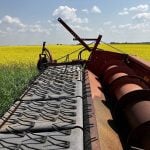The Alberta government has a new system to cut greenhouse gas emissions from farming. Farmers can earn carbon offsets if they provide documentation that since 2002 they have changed nitrogen management on cropped land in ways that lower the risk of nitrous oxide (N20). But the returns won’t be huge at present prices.
A team of scientists sponsored by the Canadian Fertilizer Institute (CFI) has defined the practices and documentation needed to reduce agriculture’s N2O emissions. It’s the first such effort in the world and the scientists hope it will help farmers around the world to cut their N2O emissions.
Read Also

Hail research hopes to benefit potato growers
Alberta research scientist measures hail storm and heat dome affects on potato crops
Agriculture is believed to be responsible for eight per cent of Alberta’s greenhouse gas emissions. Around the world, emission of nitrous oxide is considered the main reason for farming’s heavy carbon footprint. It’s not actually a carbon footprint but greenhouse gases are calculated as carbon dioxide equivalents (CO2e). N2O is a powerful greenhouse gas with 310 times more 100-year global warming potential than CO2 when it comes to acting like a piece of glass high in the atmosphere, letting heat in to warm the earth but not allowing it to escape.
N2O is released when nitrates in soil, manure or crop residues are broken down by bacteria, either in the field or in runoff or leachwater. Growing canola in high-moisture areas can result in emissions of about three kg of N2O per hectare. For comparison, a diesel engine emits 0.4 kg of N2O per litre of fuel and gas engines emit about half that.
Fertilizer manufacture also releases greenhouses gases, mainly CO2 from fossil fuels, but also N2O from making nitrate fertilizers. However, the new protocol only addresses losses from soil-applied fertilizer and manure.
Payment not attractive?
The protocols were published by the CFI in November but the provincial government has to incorporate the protocol into its regulations before farmers can qualify for carbon offset credits.
Some people in the offset business don’t see the new protocols increasing what they say is very little interest from farmers because Alberta’s $15 per tonne cap on carbon offsets is too low. Bill Dorgan, president of Agri- Trend Aggregation, doesn’t agree, and says many farmers are taking advantage of the program.
“The potential to gain carbon offsets does make a difference,” he says. “Over the last several years, we’ve seen farmers reconfigure their seeding equipment, putting on narrower openers to meet the requirements for the reduced tillage offsets.
“The payment is finally some recognition for farmers as environmentally conscientious stewards,” Dorgan says.
The 4Rs
The N2O reduction protocol the Alberta government is reviewing is a series of N management practices that reduce the risk of N2O emissions from the soil. The CFI calls these BMPs (beneficial management practices) the 4Rs of nutrient management – Right source, Right rate, Right time and Right place. 4R nutrient management is generally the most economical as well as the most environmentally-friendly way to apply N.
The protocol has three levels of N2O emission reduction: basic, medium and advanced. At the basic level, the right source to reduce N2O emissions is ammonium- based fertilizer – urea, ammonium sulphate, anhydrous ammonia, but not ammonium nitrate (34-0-0). Right rate is developed from soil tests or nitrogen balance – figuring the N available to and removed by the previous crop. Right time is applying manure – tested for its N level– or fertilizer in spring or after the soil cools in fall. Right place is applying fertilizer in bands or injecting manure either in spring or after the soil cools in fall.
At the more advanced levels of emissions reduction, the protocol calls for an annual N stewardship plan that takes into account the risk of denitrification in various landscape positions on the farm. Digital maps and some level of site-specific N management are required. Even at the basic level, aerial photos are needed, as well as some sort of yield monitoring, although it could be a simple estimate of total tonnes from each field.
Because the aim is to reduce N2O emissions, a farmer has to document baseline management and yield, as well as changes such as taking annual soil tests to move to the full 4R program.
There’s also a requirement to have a professionally approved nitrogen-management plan with specific accreditation for the professional advisors. These advisors will calculate the change in N2O emissions for each crop on the farm using fertilizer use, yields, estimates of leaching and denitrification to find the carbon offsets generated.
Example
The protocol includes an example of 500 hectares – two sections of canola grown around Red Deer, where canola is estimated to produce three kg of N2O per hectare. Improving N management could cut N2O emissions enough to generate 84 tonnes of CO2e in a project year and remain in a project for eight years. At $15 a tonne for carbon offsets, that’s a payment of $1,260, around $1 an acre for each of eight years.
Dorgan says the protocols will lead good producers to see ways they can cut their N2O emissions. There will be more soil testing, so farmers will be applying N to meet he actual needs of the crop, not guessing and not over-applying N.
“When the government develops its regulations on nitrous oxide, it will make a difference to the way people farm, he says. “It will encourage farmers to adopt better fertilizer application, less broadcasting, maybe split applications of N and potentially the use of more controlled-release fertilizer.”
———
“Whenthegovernmentdevelopsitsregulationsonnitrousoxide,itwillmakeadifferencetothewaypeoplefarm.”
BILL DORGAN
AGRITREND AGGREGATION
———
“Thepaymentisfinallysomerecognitionforfarmersasenvironmentallyconscientiousstewards,”
BILL DORGAN
PRESIDENT OF AGRI-TREND AGGREGATION














